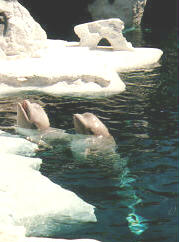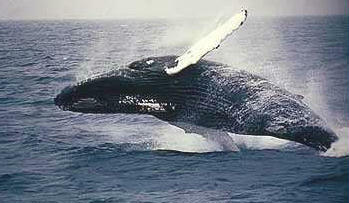

whales and sound pollution
All are familiar with the damage cased by the pollution of human waste to the marine ecosystem. The oceans have been used as a dump for oil, garbage and even atomic waste. Sound has also found its way into being a notorious pollutant of the ocean waters. For centuries the sounds of ships have rumbled through the seas. Today, to add to the noise of the ships, we have the blasts from underwater oil drilling, the ping from fishery nets, the use of low frequency active sonar and acoustic thermometry.


beluga whale and calf (http://www.marinemultimedia.com/)
Since 1990, almost $40 million has been put into detecting the temperature of the ocean using sound. The Acoustic Thermometry of Ocean Climates (ATOC) uses the principal that sound travels faster in warmer waters to get an average temperature of the ocean. Loudspeakers were installed off the coast of Hawaii and California. Thousands of underwater microphones spanning the Pacific recorded the arrival times and from this data a temperature could be calculated. The advantage of ATOC is that it provides an average temperature of thousands of miles. The data would prove important in investigating global warming and the green house effect. ATOC arose controversy amongst scientists and environmentalists. Essentially the fight came down to those whom are more concerned by the welfare of the animals and those whom are more concerned about global warming. Obviously the controversy left the two groups divided. The general consensus seems to be that there is no proof that the frequencies emitted had any directly adverse effects on the whales, but it is very difficult to make any accurate judgment. The project is running low on funds and is expected to come to a close in the next few years.
Since the mid 1980's, the military has been experimenting with active SONAR. Before this time, the Navy employed passive SONAR techniques which could track enemy subs. Today with quieter subs, the Navy hopes to employ active Sonar which releases a signal between 75-1000 Hz. In essence the sonar would echolacate hostile submarines. Due to the controversy over animal welfare, the Navy was pushed by the Natural Resource Defense Council to gather data for an environmental impact statement.
Several adverse effects have been demonstrated during High intensity sound studies. A few are listed below.
Why are we concerned with noise on the surface if the whales communicate deep within the ocean? Well, it just so happens that the sounds from the surface couple into the SOFAR channel and most of the noise you hear down in the deep channel is due to what's happening on the surface. The whales and other marine animals are not only immersed in the underwater noise pollution, but also the noise upon the surface.
 Whales
depend upon sound for mating, to find food, to communicate with
their young, to navigate and possibly much more. Sperm whales,
for example, may scan up to 400 meters to hear the faint echo
of a squid. Sound is used as a defense. The distant calls of killer
whales provide valuable time for escape or provide protection
of a calf. Some environmentalist as well as scientist fear that
all of the background noise may prohibit everyday functions of
these great creatures and thus may result in harm or even death.
Whales
depend upon sound for mating, to find food, to communicate with
their young, to navigate and possibly much more. Sperm whales,
for example, may scan up to 400 meters to hear the faint echo
of a squid. Sound is used as a defense. The distant calls of killer
whales provide valuable time for escape or provide protection
of a calf. Some environmentalist as well as scientist fear that
all of the background noise may prohibit everyday functions of
these great creatures and thus may result in harm or even death.
The right whales off Cape Cod have already suffered permanent hearing loss from the amount of background noise to which they are exposed. Their poor
a humpback (http://elfnet1a.elfi.com/gwf.html)
sense of hearing has resulted in all to frequent fatal collisions with nearby ships. The Clinton administration has passed a law requiring that ships make way for these whales.
Whether or not the above occurrences are directly related to the low frequency noise is not for certain. One must remember that all kinds of factors play a role in the sound signal. The intensity drops off as the distance from the source increases. Whales at different depths will hear different intensities of sound. Whether or not these issues are directly related is perhaps not the question at hand, perhaps the risk of the possibility alone is simply too great.
There are only eleven species of whales, not very many when compared to fish or birds. Their numbers have dropped to in some cases beyond recovery. The blue whales alone are estimated to be at only 5% their original number. How can we risk anymore?